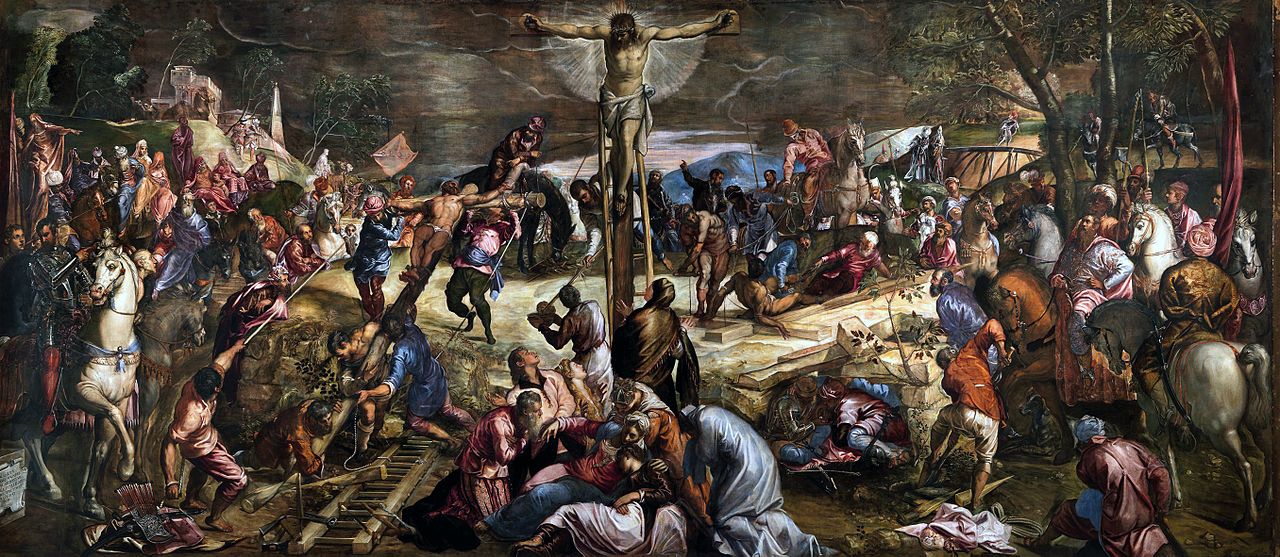The Scuola Grande di San Rocco: a bit of history
_-_Il_Salone_Maggiore.jpg)
The Scuola Grande di San Rocco was founded in 1478 as a Battuti school. At the end of the century, the first seat of the confraternity began to be built near the Franciscan sanctuary of the Frari: the first two buildings were the church, intended to preserve the relics of the patron saint of the plague victims and the small building to the right of the church itself, later nicknamed little school.
The fame of the School grew enormously in the modern era, thanks to the extraordinary veneration paid to San Rocco: his miraculous powers attracted a great mass of pilgrims to his tomb, thus increasing the economic and political prestige of the institution. In 1789 the Scuola Grande was elevated to a confraternity by Pope Pius VI, and was the only one of all the other Venetian schools not to be affected by the suppression of the French Decade, which had fallen upon the ecclesiastical institutions of the Italian peninsula. Unfortunately, however, the action of the French had its effects: the School had to renounce, in fact, most of its economic resources. Fortunately, he could retain ownership of his buildings with his priceless treasure of art.
Today the Scuola Grande di San Rocco is still active in the area and carries out its charitable mission every day thanks to the collaboration of its three hundred brothers.
The Scuola Grande di San Rocco: in the name of Tintoretto

The Scuola Grande di San Rocco is a real museum, and it would take rivers of ink or keystrokes describe its history. What must necessarily be highlighted, however, is the extraordinary partnership created between the institution and the great Venetian painter Jacopo Robusti, known as Tintoretto. Let's briefly follow the stages.
In 1564 the two main organs of the school, Banca and Zonta, decided to decorate the ceiling of the Sala dell'Albergo, where the confreres met for their own assemblies. All the greatest artists of the time participated in the competition announced by the School, but it was Tintoretto who won the commission with a clever stratagem: instead of the usual sketches, he placed the canvas with San Rocco in Gloria already on the spot! The solution was successful, and the painter touched the decoration of the Hall with Stories of the Passion of Christ: the famous Crucifixion, a cover image of every art history manual, was unforgettable.
In 1575 the enterprising Tintoretto proposed for the decoration of the ceiling of the Capitular Hall, the place where the plenary meetings were held. With The erection of the bronze serpent, Tintoretto began the vast decorative cycle: a good 33 were the works depicting in particular Stories of the Old and New Testament.
In 1582 the Venetian artist undertook to realize also the decoration of the Sala Terrena, the hall of passage of the School: he realized, for this purpose, 8 splendid canvases depicting Episodes of the childhood of Jesus and episodes of the life of the Virgin.
Despite the long series of commitments already undertaken, Jacopo had time to take care of the decoration of the church. For the latter, the artist created the four canvases with Stories of San Rocco for the presbytery and other works including La Piscina Probatica and the decoration of the organ doors.
San Rocco, Giorgione and the others...
_-_Cappella_maggiore.jpg)
A visit to the Scuola Grande di San Rocco must necessarily include the homage to the titular Saint kept in the magnificent tomb-altar of the presbytery. The spectacular machine was designed by Venturino Fantoni starting in 1516, and its execution was led by Pietro Bon. In 1520 the definitive translation of the body of the Saint took place in the new home, although still incomplete. The seven statues that decorate the sacred monument are to be attributed to the chisels of Bartolomeo Bergamasco and Gianmaria Mosca.
But what are the other must-see wonders of this wonderful temple of Venetian culture? Here they are:
- the infamous Christ Portacroce, oil on canvas made in 1505 by Giorgione, and in the past considered the work of Titian;
- the moving Annunciation painted by Tiziano Vecellio in 1535;
- the two paintings made in 1743 by Giambattista Tiepolo for the passage of the staircase leading to the Sala del Tesoro representing Abraham and the Angels and Agar and Ishmael;
- the marvelous Staircase with the baroque decorations executed by Giovanni Antonio Fiumani, Pietro Negri and Antonio Zanchi;
- the Treasure Room built between 1770 and 1773 by Giorgio Fossati, where silvers, reliquaries and other precious objects that belonged to the School are kept.
The Scuola Grande Arciconfraternita San Rocco is located in the District of San Polo and respects the following times:
- the Scuola Grande is open from 09:30 to 17:30. Closes at Christmas and New Year
- the church is open from 09:30 to 17:30, and at Christmas, Easter and New Year the church is available from 09:30 to 17:30.
The main rates for entry are:
- Large school ticket 10 euros; reduced 8 euros
- Church 2 euros.










Lascia un commento